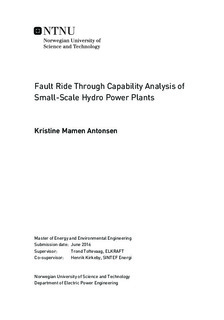| dc.description.abstract | This master thesis has looked upon the fault ride through capability assessment for small-scale hydro power plants in the distribution grid. In this report, the shape of the voltage dip has been studied, and the voltage angle impact on critical clearing time has been analyzed. A model of the Snåsa grid has been used to study faults with the simulation program SIMPOW. The SINTEF DipLab has been simulated, and the results from simulations have been compared to measurements made during experiments at Bruvollelva power plant. An in-house lab has been built to study the significance of the surrounding grid, as a weaker grid connection theoretically increases the voltage angle fluctuations, and hence decreases the critical clearing time of the generator.
When studying the voltage dips caused by three phase symmetrical faults in the distribution grid, the location of the fault has proven to be important. One of the reasons is the difference in voltage angle. The voltage dips with origin in a fault in a parallel radial to the point of measurement gives a small fluctuation in voltage angle, while faults between the point of measurement and the swing bus creates larger changes in voltage angle. The reason is that the whole load flow changes when the swing bus is disconnected, and the DG units have to cover all the demand.
The critical clearing time for the distributed generating unit Bruvollelva was simulated in this report for two different cases. A symmetrical fault was implemented, and the same voltage profile was then implemented without the same voltage angle response. The increase in critical clearing time was about 20\% for the voltage dips with origin between the DG unit and the swing bus, while the increase was much lower for the faults with origin in a parallel radial. A correlation can be seen, as the faults leading to the highest fluctuations in voltage angle was the same faults that gave the largest increases in clearing time. This indicates that the voltage angle has a considerable impact on the critical clearing times of the machine, and hence a considerable impact on the fault ride through capability assessment. The implementation guidelines for network codes amplifies the importance of the short-circuit capacity at the connection point in the pre-fault and post-fault condition. The robustness of the network has significant impact of the FRT performance, and a minimum requirement for short circuit capacity should be defined in the national FRT restrictions.
An in-house lab was built to verify the results from the simulations. The outcome was surprising, as a weak grid connection lead to a clearing time of 600 ms when the generator was operating at 7 Nm, while the stronger grid connection made the generator trip at 500 ms. The experiments should however have been made with a longer cable, and should be repeated to increase the credibility of the results.
Another verification of the simulation model was made when the measurements from the experiments made at Bruvollelva was compared to simulations. The results showed that the voltage dips were similar. Protection relays should also have been implemented to the simulations model, as they were a limiting factor when it came to the clearing time of the fault.
Generally, the measured dips caused by the DipLab were more square shaped than the simulated dips. It has been showed that the voltage due to a three phase fault is less square shaped at the generator nodes than in the rest of the system due to a higher inductance in the short circuit impedance. This is especially the case for periods with high production. | |

